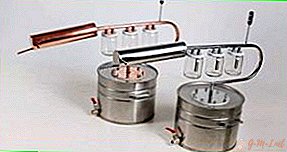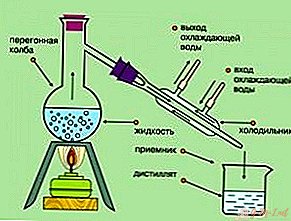 A variety of physico-chemical processes of the conversion of liquids from one state to another, allows the use of the resulting products both in everyday life and in industry. Distillation is one of the ways that alchemists have used since ancient times to change the properties of various consistencies.
A variety of physico-chemical processes of the conversion of liquids from one state to another, allows the use of the resulting products both in everyday life and in industry. Distillation is one of the ways that alchemists have used since ancient times to change the properties of various consistencies.
What is a distiller for?
The scope of use of devices for changing the properties of liquids is very large. They are used in order to:
- purification of ethyl alcohol from impurities;

- the creation of perfumes by the method of separation of aromatic substances and essential oils;
- separation of oil products into different types of fuel and resins;
- purification of medications;
- production of purified distilled water, which is widely used in the automotive and industrial fields.
Depending on the tasks, distillers have different sizes and specifics of the physicochemical process of distillation of a liquid from one state to another.
The device and principle of operation of the device
The way the distiller works is known to every person who has had to deal with home brewing. Apparatus for distillation and purification of water, works as follows:
- a large tank with the initial consistency is heated to boiling point and slow down the heating to maintain the evaporation process;

- droplets of steam that accumulate in the upper part of the tank are sent to a cooler (sometimes called an evaporator), which changes its properties and purifies the liquid from unnecessary impurities;
- after conversion and purification, the resulting product is sent to a container for collection.
The description is simple, but the distillation process is actually complicated. The method of collecting steam in the upper part of the tank can be performed with additional cooling of the upper cavity or using a funnel. And the cooler is made in the form of a separate vessel or spiral, located in a tank with a forced lowering of the temperature, the value of which affects the quality of liquid purification. The material and diameter of the tubes, the number of turns of the spiral and the direction of movement of the vapor in the distillation system have a great influence on the quality of the purified water.
IMPORTANT! For the correct operation of the equipment, the resulting steam must move up and down the pipelines and the evaporator!
The size of household distillers capable of producing a small amount of purified water allows you to install the equipment on the stove and on the working kitchen table. The dimensions of industrial units depend on the volume of distillation and can occupy separate rooms or workshops.
REFERENCE! Purification by condensation of steam in a liquid allows you to get products devoid of harmful impurities! Treatment of some specific diseases requires the use of distilled water periodically!
With frequent consumption of distilled products for technical or medical purposes, sometimes you have to deal with a low degree of purification of the purchased fluid. In order for the used water to meet the desired requirements, it is best to prepare it yourself, or rather, using a distiller, hand-made.
What you need to make a distiller yourself
 Before you make the unit, you need to prepare two containers: one for boiling, the second for collecting purified water. The first should be hermetically closed; for this, you can use an old kettle or pressure cooker. The second tank is less demanding on design features.
Before you make the unit, you need to prepare two containers: one for boiling, the second for collecting purified water. The first should be hermetically closed; for this, you can use an old kettle or pressure cooker. The second tank is less demanding on design features.
For the manufacture of the evaporator and the connection of the vessels you will need a metal tube, preferably made of brass, due to the flexibility of which they make a spiral. To make the connections of the container with the tube tight, you will need a bench tool, soldering iron, clamps or wire. In addition, you will need a device for the manufacture of the spiral, the capacity of the cooler and a hose of the corresponding diameter to connect all structural elements.
ATTENTION! Do not use old rusty pots or tubes to assemble the distiller! The selected material must be of good quality and not exposed to corrosion or high temperature!
Before assembly, it is advisable to sketch with a reflection of the layout of the nodes and connections of all elements of the assembly. The presence of such a figure will help to assemble the unit.
The manufacturing process of the apparatus
When assembling a distiller, several stages of work are necessary.
- A hole is made in the lid of the boiling container, which is equipped with a sealed flange pipe or a small piece of pipe is soldered for subsequent connection with a steam outlet hose.
- Check the plane of closing the lid for leaks. In the absence of such, a rubber sealant is made that can withstand the boiling point.
- After that, make braces that will fix the lid in the closed position. In the absence of such fasteners, use a heavy object to prevent the lid from bouncing and steam leaking during boiling.
- For the manufacture of a spiral, a cylindrical template in the form of a plastic pipe or other object is used. The diameter of the device is selected so that, after twisting, the spiral fits into a previously prepared cooling tank.
- Using a hose, connect the boiling tank, the evaporator and the receiving tank. Clamps or wire clamp all hose connections.
The distiller is ready to go. Pour water into the main tank and cooler. All elements are arranged alternately from top to bottom and begin to purify the water. The independent operation of such a unit will allow you to get the desired quality of liquid purification.
ATTENTION! Before cleaning tap water, it must be defended for at least eight hours! Neglect of this recommendation will reduce the degree of purification!
The made distiller will purify water at home. If it is necessary to obtain essential oils, the manufacture of a more complex structure is required.



Leave Your Comment